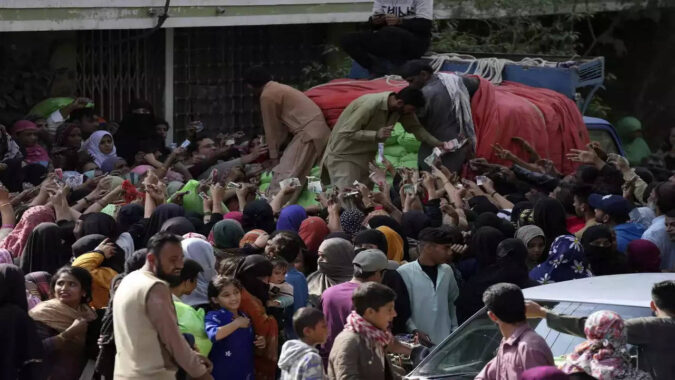Pakistan is deep in debt and must enact tough tax reforms and push up utility prices if it hopes to unlock another tranche of a $6.5 billion IMF bailout and avoid defaulting. The measures have, however, resulted in skyrocketing inflation that has triggered a food crisis in the country.
Rising prices
The short-term rate of inflation measured by the Sensitive Price Indicator (SPI) last week hit a record 46.65%, while monthly inflation recorded by the Consumer Price Index reached 31.6% in February, according to data released by the Pakistan Bureau of Statistics (PBS) on Saturday.
Month-on-month inflation was 3.72% while the average inflation rate for the past year was 27.26%.
According to the PBS, prices in urban and rural areas increased 32.97% and 38.88% YoY, respectively. Consumer prices have risen sharply over the past several months, with annual inflation staying above 20% since June last year.
‘Famine-like situation simmering’
A battered economy due to low forex reserves and with consequences of a massive flood to deal with, authorities in Pakistan are finding it increasingly difficult to fulfill the basic food requirements of the citizenry.
Poor Pakistanis are feeling the brunt of the economic turmoil, and at least 20 people have been killed since the start of the Muslim fasting month of Ramzan in crowd crushes at food distribution centres.
The country is facing the worst food crisis in its history, with flour becoming increasingly scarce. Local media reports indicate that flour prices have gone up to PKR3,000 a packet and fights and brawls over flour are common on the streets of Pakistan.
Wheat and flour-loaded trucks are moved in Pakistan escorted by armed guards.
The price of ordinary snacks like samosa and pakoras are so high that poor people, who once relied on them for filling up their stomachs after fasting, have to make do with leftovers in shops, as per local news reports.
At least 12 people were killed on Friday in a crowd crush in Pakistan’s southern city of Karachi at a factory distributing Ramadan alms.
“The way inflation is rising, I believe a famine-like situation has been simmering,” said Shahida Wizarat, a Karachi-based analyst.
Authorities in Pakistan say the food crisis may grow worse in the coming days as much of the wheat in stock has been exhausted.
Worse yet to come?
In its Monthly Economic Update and Outlook, the Pakistan finance ministry has warned that inflation is likely to rise further due to a second-round effect of policy decisions made earlier to raise energy and fuel prices, the central bank’s policy rate, and the rupee’s depreciation to secure IMF funding.
Years of financial mismanagement and political instability have pushed Pakistan’s economy to the brink of collapse, exacerbated by a global energy crisis and devastating floods that submerged a third of the country in 2022.
The country needs billions of dollars of financing to service existing debt, while foreign exchange reserves have dwindled and the rupee is in freefall.
The ministry also noted that the delay in finalising the IMF bailout was causing further economic distress. “The economic distress resulting from delay of the stabilisation programme has exacerbated the economic uncertainty due to which inflationary expectations have remained strong,” the report said.
Economic slowdown
The finance ministry noted that the average Monthly Economic Indicator (MEI) during the first eight months of the current fiscal year indicates a further slowdown in domestic economic activities.
The slowdown seems to be driven by a lack of industrial dynamism, accelerating inflation, which erodes the purchasing power of consumers and investors and is also illustrated by negative growth in exports and imports.
The indicator was already in negative territory since the start of the fiscal year. The ministry’s latest assessment indicates that there may not be any growth during the current fiscal year if no improvement is witnessed in the remainder period.
(With inputs from agencies)
Watch Pakistan’s food crisis: Clashes erupt over distribution of free government wheat flour during Ramzan
